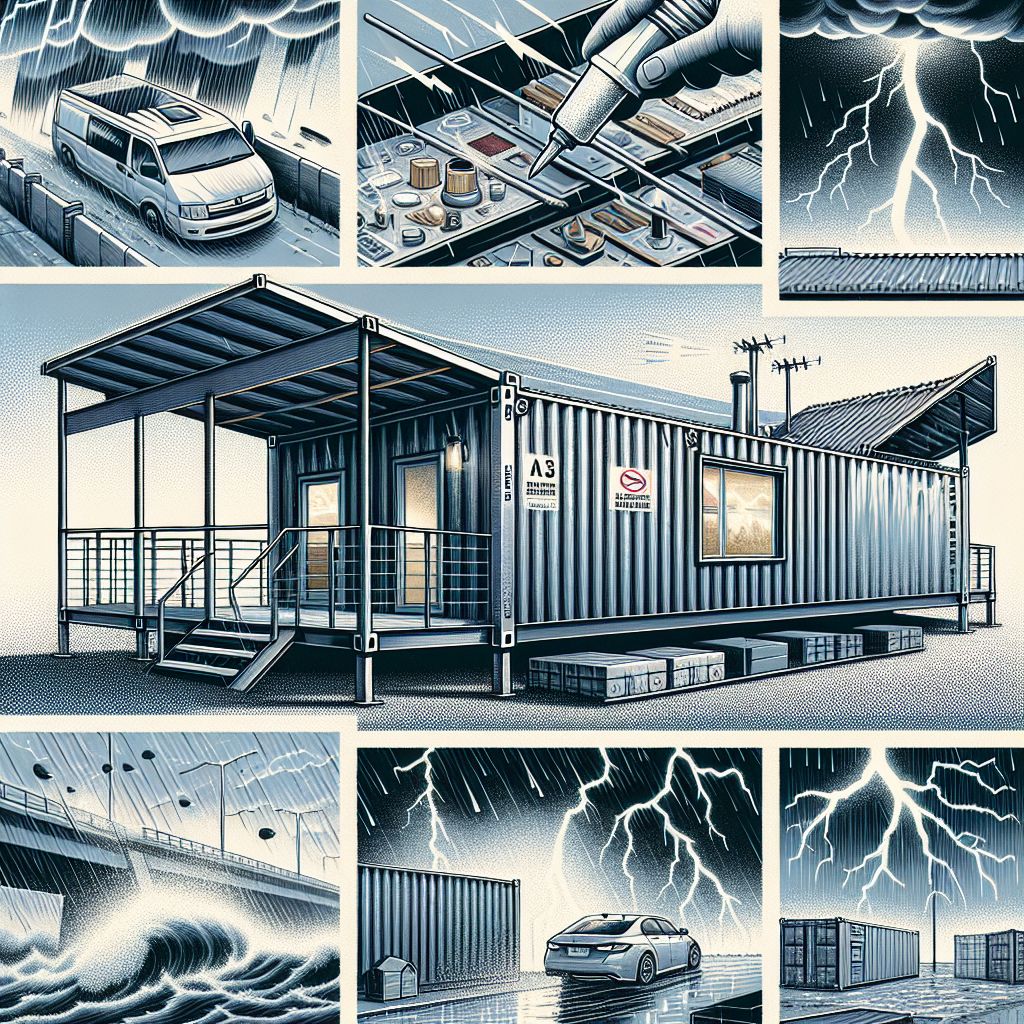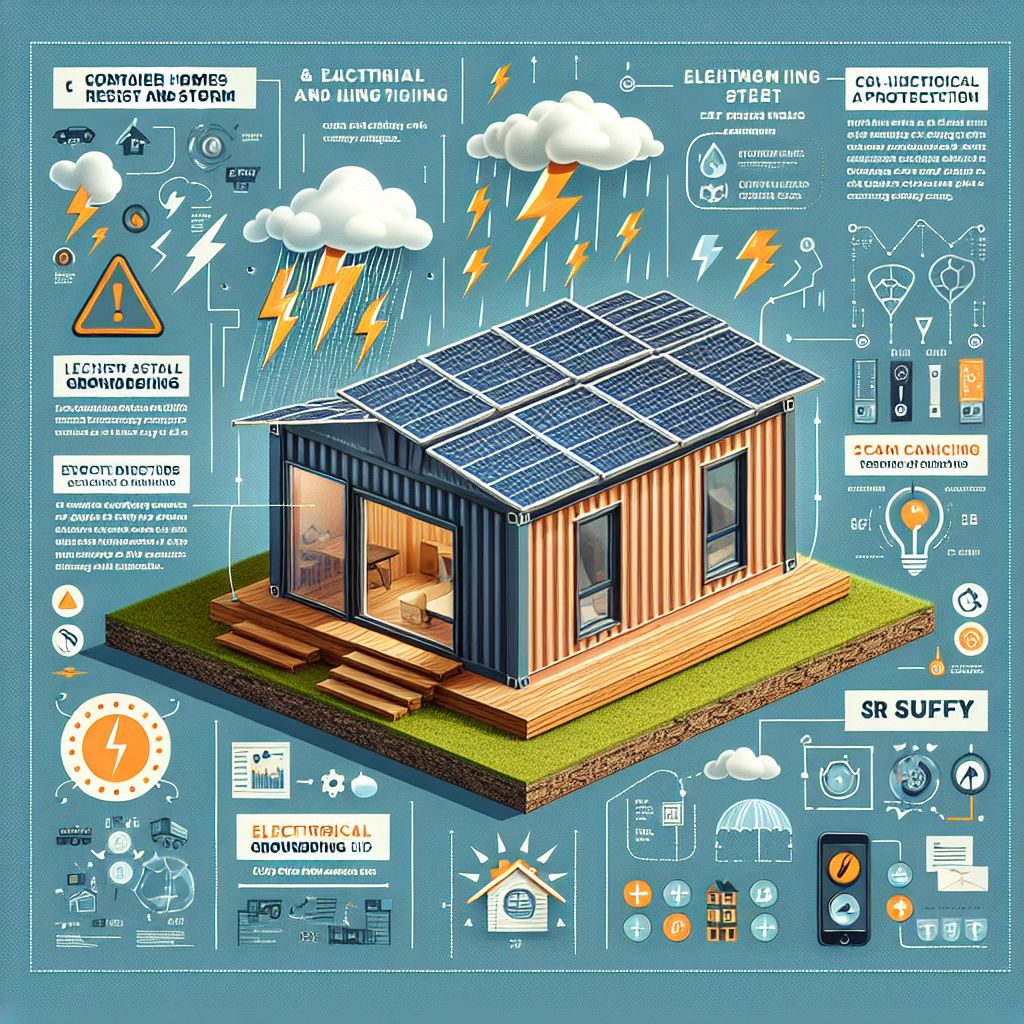
Key Takeaways
- Container homes need specialized design to withstand lightning and severe storms.
- Proper lightning protection includes rods, grounding, and surge protection for electrical systems.
- For storm resistance, container homes must be anchored and reinforced to handle high winds.
- Regular inspections and early warning systems are crucial for maintaining safety.
- Understanding the risks and preparation is key to ensuring container home durability in extreme weather.
The Need for Robust Container Home Safety
When we talk about our homes, we’re talking about our sanctuaries. But when your sanctuary is a container home, you’ve got to think about safety a little differently. These structures, known for their sustainability and cost-effectiveness, face unique challenges when it comes to lightning and storms. Here, we’re not just ensuring a safe home, but a resilient one too.
How Lightning Targets Homes
Let’s get down to brass tacks. Lightning is attracted to tall, isolated, and metal objects, which means container homes can be like a beacon in a storm. Because they’re often made of conductive materials, they can quickly become a path for lightning to reach the earth. But fear not, with the right protection in place, this risk can be managed effectively.
Did you know? A lightning bolt can carry up to 1 billion volts of electricity. That’s why grounding your container home is not just a good idea; it’s a necessity.
Table of Contents
My Favorite Container Homes Resource
I compared the top 3 Container Home Guides
to discover the ultimate resource!
See my top recommendation here
Building a Foundation of Safety
It all starts with a solid foundation. Whether you’re in an area prone to thunderstorms or high winds, your container home needs to be prepared to face the elements head-on. This means not just thinking about the immediate protection from lightning strikes, but also ensuring that your home won’t budge an inch when the winds pick up.
Most importantly, the steps you take to secure your home against the weather aren’t just about the materials you use, but how you use them. It’s like putting together a puzzle; every piece needs to be in the right place for the big picture to come together.
Securing the Structure: Anchors and Foundations
Anchoring your container home isn’t just about keeping it in place; it’s about making sure it can withstand the forces that nature throws its way. For more insight on creating a stormproof container home, explore our comprehensive guide on resilience tips for structural integrity.
- Choose the right type of foundation: whether it’s a pier, strip, or slab, it needs to match the soil type and environmental conditions of your location.
- Use heavy-duty anchors: these will tie your container down and prevent it from becoming a giant metal kite during a storm.
- Ensure proper welding: the points where containers connect need to be strong enough to resist tearing apart in high winds.
Because your home’s safety is the priority, these steps are not just suggestions; they’re essential to ensuring your container home stands firm against the storm.
The Role of Grounding in Container Homes
Grounding is your container home’s best defense against lightning. It’s a way of making a safe path for electricity to travel to the ground, without passing through the rest of your home. Think of it like a dedicated road for lightning to travel on, away from the places you live and sleep.
- Install a lightning rod: This is the starting point for the lightning’s journey to the ground.
- Connect it to a grounding system: This includes conductors and ground rods that divert the electricity safely into the earth.
- Check local codes: Make sure your grounding system meets the safety standards set by your local regulations.
Surge Protection: Your Electrical Systems Defended
Surge protection is like a goalkeeper for your home’s electrical system. When a surge from a lightning strike tries to score a goal, the surge protector blocks it. It’s an extra layer of defense that ensures your appliances and electronics aren’t fried during a storm. Make sure you:
- Choose surge protectors with a high joule rating: This tells you how much energy it can absorb.
- Install surge protectors at your main electrical panel and at individual outlets.
- Regularly inspect your surge protectors: They can wear out over time, especially after deflecting a big surge.
References:
[1] https://icontainerhome.com/lightning-protection-of-container-houses/
[2] https://www.youtube.com/watch?v=xBczUD2p9ZU
[3] https://portshippingcontainers.com.au/blog/shipping-containers-and-lightning
[4] https://fse-automation.com/blog/all-about-home-container-security-resistance-and-safety/
[5] https://www.linkedin.com/pulse/container-homes-prove-storm-safe-florida-nick-caster
[6] https://physics.stackexchange.com/questions/242156/
[7] https://www.livinginacontainer.com/is-it-safe-to-live-in-a-container/

Bracing for the Wind
When the wind howls like a pack of wolves at your door, your container home needs to be ready. This means not only securing it to the ground but also designing it to minimize wind resistance. The shape of your home, the placement of its containers, and even the landscape around it can all affect how well it stands up to the wind.
Remember, the wind is a powerful force that can find its way into any little nook and cranny. So, you need to make sure there are no weak spots where the wind can get a grip and start pulling things apart.
Wind-Resistant Design Features for Container Homes
Designing for wind resistance is like dressing for a storm; you want to be covered from all angles. Here’s how you do it:
- Use aerodynamic design principles: Smooth, rounded edges can help deflect wind away from your home.
- Install windbreaks: Strategic placement of trees and shrubs can reduce wind speed before it hits your home.
- Reinforce with strapping: Metal straps can help hold the roof and walls firmly in place during high winds.
Materials That Weather the Storm
The materials you choose for your container home are like the armor it wears into battle against the elements. You want something that’s tough, durable, and able to take a hit without breaking. Here’s what to look for:
- High-quality steel: The core material of your container home should be corrosion-resistant and strong.
- Impact-resistant windows and doors: These can prevent breakage from flying debris.
- Weatherproof seals and coatings: These keep water and wind from sneaking in through the cracks.
Because these materials are your first line of defense, investing in quality here means peace of mind when the storm clouds gather. For more detailed guidance, check out our stormproof guide for container homes.
Prevention Through Detection
Knowing a storm is coming before it arrives gives you time to prepare. That’s why early warning systems are a crucial part of container home safety. Whether it’s a high-tech weather station or a simple app on your phone, staying informed about the weather can make all the difference.
Installing Early Warning Systems
With the right tech in place, you can be alerted to severe weather before it hits. Here’s how to stay ahead of the storm:
- Invest in a weather station: It can provide real-time updates on conditions like wind speed and lightning activity.
- Use weather alert apps: They can send warnings directly to your phone or other devices.
- Sign up for community alerts: Local emergency services often have systems to notify residents of severe weather.
Mitigating Risks with Regular Inspections
Routine inspections of your container home are like regular check-ups with a doctor; they help catch issues before they become serious. At least once a year, give your home a thorough examination, paying special attention to:
- The integrity of your home’s anchoring system.
- Any signs of rust or corrosion on the container itself.
- The condition of seals around windows and doors.
By keeping a close eye on the condition of your home, you can take proactive steps to maintain its safety and integrity, no matter what the weather brings.

Frequently Asked Questions (FAQs)
How do container homes compare in safety to traditional homes?
Container homes, when built and anchored correctly, can be incredibly sturdy. Their steel construction offers strong resistance to severe weather, such as high winds and even earthquakes. However, they must be equipped with the appropriate safety systems, such as lightning rods and grounding, to be as safe as traditional homes during storms.
Are there specific regions where container homes are more vulnerable?
Yes, container homes in regions with high lightning activity or prone to hurricanes and tornadoes require additional safety measures. For instance, in the Tornado Alley of the United States, container homes need to be anchored securely and may benefit from reinforced designs to withstand the high wind speeds of tornadoes.
What are the steps to anchor a container home properly?
To anchor a container home properly, follow these steps:
- Choose type a foundation suitable for your terrain and climate.
- Install heavy-duty anchors into the foundation to hold the containers down.
- Ensure all welding points between containers are secure and tested for strength.
How often should container homes be inspected for storm-worthiness?
Container homes should be inspected at least annually for storm-worthiness. Before storm seasons, it’s prudent to check the integrity of anchors, the condition of the roof and walls, and the functionality of lightning and surge protection systems.
Can a container home survive extreme weather events like tornadoes or hurricanes?
With the right design and anchoring, a container home can survive extreme weather events. They can withstand winds up to Category 3 hurricanes when properly reinforced. However, no home can be made entirely invulnerable, and safety precautions should always be taken in extreme conditions.
In conclusion, while container homes present a unique set of challenges when it comes to lightning and storm safety, with thoughtful design and preparation, they can offer a secure and durable living space. Remember, the key to storm safety in a container home is preparation, quality materials, and regular maintenance. By taking these steps, you can enjoy the benefits of sustainable living without compromising on safety.
For more information on the durability and safety of container homes in adverse weather conditions, check out our detailed guide on storm-proof insulated homes.





